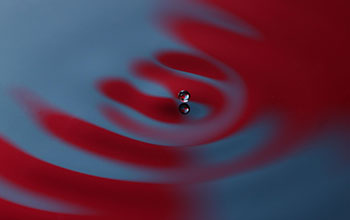Multimedia Gallery
"Walking in Color"
"Walking in Color," by Daniel M. Harris and John W.M. Bush.
Quantum physics measures movements of the tiniest particles in the universe, which not only happen incredibly quickly and on very small scales, but also defy physicists' intuition. Analogies from the macroscopic world can help scientists visualize quantum-like phenomena more easily. Daniel Harris, then a doctoral student at MIT, turned to a quirky relationship between liquid droplets and a vibrating bath.
The vibration stops the droplet from assimilating into the bath, and it bounces across the surface instead. The droplet and the waves it creates mimic some of the statistical behaviors of quantum particles -- except they're visible to the naked eye. The photo is one of several hundred Harris took for his doctorate, all snapped with an off-the-shelf camera.
More about this image
This illustration won experts' choice in the Photography category of the 2016 Visualization Challenge, now called the Vizzies, a long-running annual competition co-sponsored by the National Science Foundation (NSF) and Popular Science magazine. [The competition was formerly named the International Science & Engineering Visualization Challenge (SciVis) and was previously co-sponsored with AAAS' journal Science.] The competition aims to recognize some of the most beautiful visualizations from the worlds of science and engineering, and awards prizes in five categories: photography, video, illustration, posters & graphics and interactives.
To learn more about the competition and view all the winning entries, past and present, see the NSF Special Report The VIZZIES: Visualization Challenge. (Date image taken: 2016; date originally posted to NSF Multimedia Gallery: Jan. 2, 2018)
Credit: Daniel M. Harris and John W.M. Bush
See other images like this on your iPhone or iPad download NSF Science Zone on the Apple App Store.
Images and other media in the National Science Foundation Multimedia Gallery are available for use in print and electronic material by NSF employees, members of the media, university staff, teachers and the general public. All media in the gallery are intended for personal, educational and nonprofit/non-commercial use only.
Images credited to the National Science Foundation, a federal agency, are in the public domain. The images were created by employees of the United States Government as part of their official duties or prepared by contractors as "works for hire" for NSF. You may freely use NSF-credited images and, at your discretion, credit NSF with a "Courtesy: National Science Foundation" notation.
Additional information about general usage can be found in Conditions.
Also Available:
Download the high-resolution JPG version of the image. (1.9 MB)
Use your mouse to right-click (Mac users may need to Ctrl-click) the link above and choose the option that will save the file or target to your computer.



